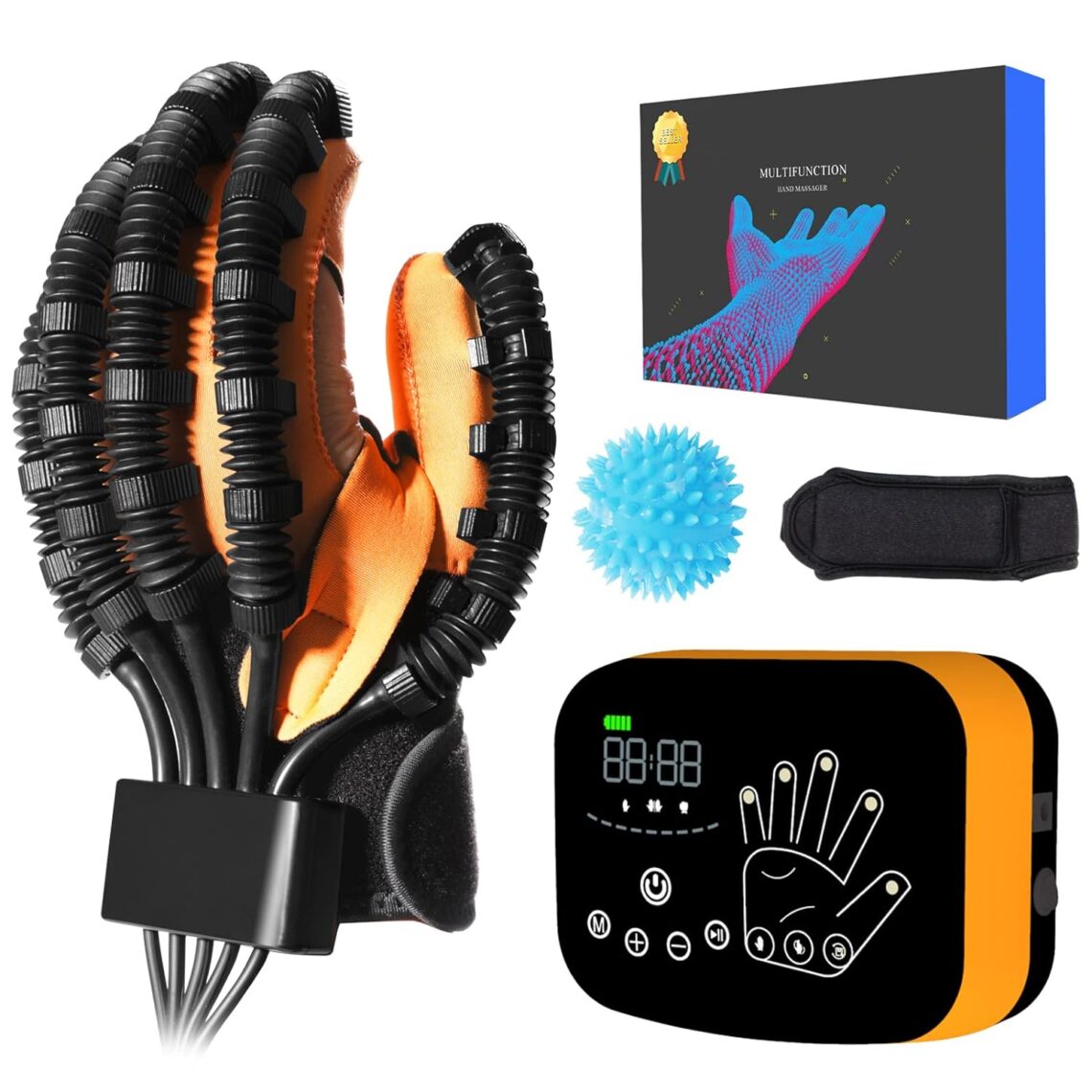Comprehensive Guide to Stroke Recovery: Duration, Diet, Positioning, and Expectations 1. How Long Is Recovery from a Mini-Stroke (TIA)? A mini-stroke, also known as a Transient Ischemic Attack (TIA), occurs when blood flow to part of the brain is temporarily blocked. Unlike a full stroke, the symptoms usually resolve within minutes to hours, and no permanent brain damage occurs. However, a TIA is a serious warning sign of potential future strokes, so it is critical to seek immediate medical care. Recovery Duration 2. What Foods Help Stroke Recovery? Nutrition plays a key role in stroke recovery by supporting brain healing,…
-
-
A stroke can be a life-altering event, impacting various aspects of an individual’s physical and cognitive function. Among the many challenges that stroke survivors face, hand problems rank among the most significant. The loss of hand function or impaired hand movement can greatly affect one’s ability to perform everyday tasks and diminish overall quality of life. In this article, we delve into the complexities of hand problems after stroke, exploring the underlying causes, common symptoms, and effective strategies for rehabilitation and recovery. Understanding Hand Problems After Stroke: Hand problems following a stroke often stem from damage to the brain’s motor…
-
A stroke does not automatically qualify someone for disability benefits, but many who suffer from stroke-related impairments might be eligible. To qualify for Social Security Disability Insurance (SSDI) or other disability benefits, the effects of the stroke must significantly impair your ability to work and perform daily activities. Eligibility Criteria Process To apply for disability benefits after a stroke, you must provide detailed medical records and possibly undergo further evaluations by SSA-appointed medical experts. If initially denied, there is an appeals process available [2]. Additional Considerations The SSA’s Blue Book, which lists medical conditions and criteria needed for disability benefits,…
-
As women, we often attribute unusual behavior or mood changes tostress, fatigue, or hormonal fluctuations. However, somebehavioral symptoms can be a sign of stroke, particularly inwomen. In this article, we will explore 20 behavioral symptomsthat may indicate a stroke is occurring. 1. Emotional DistressWomen experiencing a stroke may exhibit increased anxiety,depression, or irritability. These emotional changes can be suddenand severe, often accompanied by physical symptoms like confusionor disorientation. 2. Mood SwingsSudden mood swings, such as becoming easily frustrated or annoyed,can be an early warning sign of stroke in women. 3. Loss of InterestA sudden loss of interest in activities previously…
-
Stroke is a leading cause of disability worldwide, with womenbeing disproportionately affected. While physical symptoms such asweakness or numbness are often well-known, cognitive-affectivesymptoms can be just as debilitating yet often overlooked. In thisarticle, we will delve into the complex and multifaceted world ofcognitive-affective symptoms in women who have experienced astroke. Cognitive Symptoms: The Often-Overlooked Signs Cognitive symptoms refer to difficulties with thinking,problem-solving, and decision-making that can occur as a result ofa stroke. These symptoms can be subtle and may not necessarilyalert someone that a stroke has occurred. In fact, many peopleexperiencing cognitive symptoms may initially attribute them tonormal aging or…
-
What are Cognitive Symptoms? Cognitive symptoms are difficulties with thinking,problem-solving, and decision-making that can occur as a result ofa stroke. These symptoms can be caused by damage to specific areasof the brain responsible for processing information, makingdecisions, and controlling our thoughts. Common cognitive symptoms of stroke include: Why are Cognitive Symptoms Important? Cognitive symptoms can be a significant indicator of stroke,particularly in women. Studies have shown that cognitiveimpairment is more common among women experiencing stroke thanmen. Additionally, cognitive symptoms can often precede othersigns of stroke, making early recognition crucial. If left untreated, cognitive symptoms can lead to long-termdisability and decreased…
-
Have you ever felt like you’re stuck in a mental haze, strugglingto focus on anything? Maybe it’s as if your mind is a thick fogthat refuses to lift, making everyday tasks feel like climbing amountain. This phenomenon is more common than you might think, andit’s often referred to as “mental fogginess.” In this article,we’ll delve into the world of mental fogginess, exploring itscauses, symptoms, and potential solutions. What is Mental Fogginess? Mental fogginess is a state of being where your mind feels cloudy,unclear, or disconnected. It’s as if you’re struggling to accessyour normal thought processes, leaving you feeling foggy,confused, or…
-
Cognitive Symptoms Motor and Sensory Symptoms Speech and Language Symptoms Visual and Spatial Symptoms Behavioral Symptoms Other Symptoms Cognitive-Affective Symptoms Motor Skills and Coordination Symptoms Other Cognitive Symptoms Neurological Symptoms Sensory Symptoms Speech and Language Symptoms Motor Skills and Coordination Symptoms Other Cognitive Symptoms Neurological Symptoms Sensory Symptoms Other Symptoms Please note that this is not an exhaustive list, and it’s alwaysbest to consult with a healthcare professional if you experienceany symptoms.
-
Hand and finger exercisers are crucial tools in the rehabilitation process for stroke survivors, helping them regain strength, flexibility, and coordination in their hands. These devices cater to patients of various ability levels and focus on improving fine motor skills crucial for daily activities. Hand and finger exercisers offer a pathway to independence for stroke survivors, enhancing their quality of life by restoring the ability to perform daily tasks independently. 🌐 Sources
-
The Fugl-Meyer Assessment (FMA) is a standardized testing protocol widely used to evaluate the physical performance of individuals who have suffered a stroke. This comprehensive guide provides an overview of the FMA, including its history, structure, and clinical importance, making it accessible and easily understandable for a broad audience. Introduction to Fugl-Meyer Assessment (FMA) Developed in 1975 by Axel Fugl-Meyer, the FMA is an index to assess the sensorimotor recovery in individuals who have had a stroke. It is one of the most extensively used quantitative measures in stroke rehabilitation worldwide. The primary aim of the FMA is to assess…
-
Stroke recovery is a multifaceted journey, encompassing not only the physical aspects of rehabilitation but also the cognitive challenges that many survivors face. Cognitive impairments, including difficulties with memory, attention, executive function, and communication, can significantly impact a survivor’s ability to regain independence and quality of life. Cognitive aids, both simple and technologically advanced, have emerged as essential tools in addressing these challenges, offering practical solutions that enhance cognitive functioning and facilitate daily living activities. This article explores the transformative role of cognitive aids in the rehabilitation process, highlighting their types, benefits, and implementation strategies. The Spectrum of Cognitive Aids…
-
When we think about communicating with those around us, the ability to speak clearly and express our thoughts feels as natural as breathing. Yet, for many women experiencing a mild stroke, speech difficulties can suddenly turn this once effortless ability into a challenging task. Recognizing speech difficulties as a key indicator of a stroke is crucial, not only for those who may experience a stroke but also for their families and friends who can help in identifying the signs and seeking prompt medical attention. Understanding Speech Difficulties in the Context of a Stroke Speech difficulties during a stroke can manifest…
-
In the landscape of mild stroke symptoms, sudden confusion and disorientation stand out as particularly elusive signposts, often blending into the background of our busy, sometimes chaotic lives. Especially for women, who frequently juggle multiple roles and responsibilities, recognizing these subtle cues can be challenging. Yet, understanding and acting upon these signs is crucial for timely intervention and can significantly impact recovery. Let’s delve into the nuances of sudden confusion and disorientation, unpacking what these symptoms really mean and why they demand our attention. Sudden Confusion and Disorientation: Unraveling the Mystery Imagine you’re in the middle of a familiar task,…
-
When we think of strength and sensation in our bodies, we often take for granted the seamless coordination and balance between both sides. However, when something as critical as a stroke intervenes, this balance can be disrupted, manifesting as unilateral weakness or numbness. This article dives deep into the nuances of these symptoms, particularly in women, shedding light on their significance, recognition, and the urgency they command in stroke awareness and response. The Significance of Unilateral Weakness or Numbness Unilateral weakness or numbness, the loss of strength or sensation on one side of the body, is a telltale sign of…
-
Sudden confusion or difficulty understanding simple tasks can be an alarming experience, not just for the person going through it but also for their loved ones witnessing it. This symptom, often subtle and easily overlooked, can signal a serious medical condition such as a stroke. Understanding this symptom in depth is crucial for timely recognition and response. What Is Sudden Confusion? Sudden confusion, also known as acute confusion or delirium, refers to a rapid onset of confusion and disorientation. This condition affects a person’s ability to think clearly, leading to difficulties in understanding simple tasks, making decisions, or engaging in…
-
Imagine going about your day, engaging in your usual tasks and conversations, when suddenly, things don’t make sense anymore. Simple tasks become puzzles, and familiar conversations feel like they’re in a foreign language. This bewildering experience isn’t just a fleeting moment of distraction; it could be a sign of a mild stroke. Strokes occur when the blood supply to part of the brain is interrupted or reduced, preventing brain tissue from getting oxygen and nutrients. While the classic signs of stroke are well-known (such as sudden numbness, trouble speaking, and vision problems), confusion and disorientation are often overlooked, especially in…
-
As we navigate through life’s later chapters, understanding the signs of a stroke becomes increasingly crucial for women over 40. This period brings its own health considerations, with strokes representing a significant risk where early symptom recognition can dramatically influence outcomes. It’s about safeguarding your future, ensuring you’re prepared to act when moments matter most. Being alert to stroke symptoms is a critical aspect of your health strategy. An abrupt loss of strength or feeling, especially on one side of the body, could signal a stroke. This can affect the face, arm, or leg, signaling an urgent need for medical…
-
In today’s fast-paced world, young women are often juggling multiple roles and responsibilities, sometimes at the expense of their health. Among the myriad health challenges, stroke stands out as a particularly deceptive threat, with crucial, yet frequently overlooked signs. It’s essential to spotlight the importance of recognizing these subtle symptoms, focusing on prevention and empowerment for a healthier future. Strokes are commonly associated with older age, yet they do not discriminate, affecting individuals across all age groups, including young women. The key to prevention lies in awareness—understanding that strokes can manifest differently in younger demographics, with symptoms that are often…
-
Introduction As we navigate through life’s later chapters, understanding the signs of a stroke becomes increasingly crucial. This guide focuses on equipping women over 40 with the knowledge to identify stroke symptoms swiftly, emphasizing the importance of early detection and prompt action without leaning heavily on a gentle approach. The Importance of Awareness Entering the fourth decade brings its own set of health considerations. Strokes stand out as a significant risk, where early symptom recognition can dramatically influence outcomes. It’s about safeguarding your future, ensuring you’re prepared to act when moments matter most. Key Stroke Symptoms Being alert to stroke…
-
When talking about stroke, one of the things that instantly comes to mind is the health condition called high blood pressure, or hypertension. High blood pressure is the main risk factor for stroke. It is a serious condition and is called “the silent killer” because most of the time there are no obvious symptoms, and people who have it are not aware that they are hypertensive. This article will talk about how high blood pressure can be a factor in having a stroke. It will also touch upon the blood pressure threshold before being at risk of having a stroke,…
























